Ijraset Journal For Research in Applied Science and Engineering Technology
- Home / Ijraset
- On This Page
- Abstract
- Introduction
- Conclusion
- References
- Copyright
Hydroponic Trough Systems for Maximising Cucumber Production
Authors: Muhammed Safvan
DOI Link: https://doi.org/10.22214/ijraset.2024.58243
Certificate: View Certificate
Abstract
Hydroponics is a promising solution to address the increasing demand for food caused by limited arable land and a growing global population. This article focuses on the use of hydroponics in cucumber cultivation, specifically highlighting the adaptability of hydroponic trough system. It explains the design elements of the trough system in detail, including configuration, growing medium, nutrient solution, and support structures. The article emphasises the advantages of hydroponic trough systems in cucumber cultivation, such as precise nutrient dispensation, space efficiency, water conservation, and potential for automation. It discusses strategies for optimal cucumber production within these systems, including temperature control, pollination techniques, pruning, and pH monitoring. The article also addresses the challenges of insect and pest attacks, introducing common pests and presenting integrated pest management strategies for effective control. It explores diseases that can affect cucumber crops in hydroponic systems, such as powdery mildew, downy mildew, Pythium root rot, and Fusarium wilt. It discusses strategies to prevent these diseases, including preventive measures, disease-resistant cucumber varieties, cultural practices, and bio methods. By considering all these aspects, a comprehensive approach to disease management can be established. Overall, adopting hydroponic trough systems in cucumber cultivation offers a sustainable and efficient solution to traditional farming challenges. By incorporating preventive measures, disease-resistant cultivars, and organic remedies, farmers can ensure a thriving cucumber harvest and contribute to a productive and sustainable agricultural future.
Introduction
I. INTRODUCTION
With the global population steadily increasing, the need to produce a greater quantity of food has become a significant challenge. To ensure sustainability, modern technologies have been introduced. In 2015, the United States projected that the world population would reach 9.6 billion by 2050, with 70% of people residing in urban areas. However, meeting the demand for food is proving to be a daunting task, as more than 70% of the available land is already being used for cultivation purposes. The traditional method of crop cultivation is facing serious issues due to the development of human and social behaviour. Continuous cultivation of crops using heavy doses of inorganic fertilisers and pesticides has led to a decline in soil fertility. Additionally, soil-borne diseases pose a significant threat to plant cultivation. In 1900, when the world population was around 3 billion, each person had access to approximately 0.16 hectares of land. However, by 2050, this per capita land availability is expected to decrease to 0.6 hectares. To address these challenges, the innovative technique of hydroponics has been introduced. John Woodward, an English scientist, is credited as the pioneer of modern hydroponics. In India, the hydroponics system was developed in 1946 by English scientist W.J. Sholto Douglas, who established the first hydroponic laboratory in Kalimpong, West Bengal. From the 1960s to the 1970s, countries such as Abu Dhabi, Arizona, Holland, Iran, Italy, California, Belgium, Japan, Russia, Denmark, and Germany commercialised hydroponics. This system allows for the cultivation of almost any terrestrial plant.
A. Hydroponics
Hydroponics is an agricultural method that employs water enriched with nutrients instead of soil to provide nourishment to plants. By utilising nutrient water supplies, the risk of process-induced eutrophication and overall pollution of land and water is minimised, as runoff in weather-independent facilities is not a concern. The term "hydroponics" originates from the Greek words "hydro" meaning water and "ponos" meaning labour, thus literally translating to "water work". Professor William Gericke coined the term in the early 1930s to describe the cultivation of plants with their roots suspended in water containing mineral nutrients. In most hydroponics systems, automation is employed to regulate the quantity of water, nutrients, and photoperiod according to the specific requirements of different plant species.
B. Cucumber
Cucumbers flourish in hydroponic systems as a result of their fast growth rate and their need for warmth, moisture, and nutrients. Generally cultivated in greenhouses, they are known for being one of the most productive plants.
II. THE HYDROPONIC TROUGH SYSTEM
The trough system is renowned for its adaptability and effectiveness in cultivating various crops in the ever-changing realm of hydroponics. However, its true allure shines when it is employed for the cultivation of cucumbers, making it an intriguing method to explore.
A. The structure and components of the Hydroponic Trough System
- Trough Design
Hydroponic troughs are linear channels that have been designed to provide a suitable environment for plants to grow. These troughs can be set up in a horizontal orientation or at a slight incline, ensuring that the flow of nutrient-rich water is optimised for the plants. The choice of construction material for these troughs may vary and commonly includes PVC, concrete, or materials that have been recycled.
2. Growing Medium
Cucumbers flourish in inert growing mediums such as coconut coir or perlite. These mediums ensure stability while also facilitating appropriate aeration and nutrient absorption.
3. Nutrient Solution
A continuous and recirculating nutrient solution is the lifeblood of hydroponic trough systems. For cucumbers, the solution should be meticulously balanced, rich in nitrogen, potassium, phosphorus, and other essential minerals crucial for robust growth.
4. Support Structures
Trellises or support structures are indispensable for cucumber plants because of their climbing nature. These structures play a crucial role in preventing overcrowding, promoting vertical growth, and aiding the efficient development and harvesting of fruits.
B. Advantages of Hydroponic Trough Systems in Cucumber Cultivation
- Accurate Nutrient Dispensation
The trough system displays exceptional performance by delivering a steady and even dispersal of nutrients to cucumber plants, thereby guaranteeing the ideal conditions for their growth and development.
2. Space Efficiency
The efficient utilisation of space is made possible by the linear arrangement of troughs in hydroponic systems. This feature makes these systems well-suited for various settings, including large-scale commercial cucumber farms as well as smaller, urban environments.
3. Water Conservation
Hydroponic trough systems are renowned for their exceptional water efficiency. Through the process of recirculating nutrient solutions, these systems significantly reduce water wastage, thereby promoting environmentally sustainable farming techniques.
4. Automation Potential
Trough systems can be easily automated, allowing for precise control over nutrient delivery, pH levels, and environmental conditions. This not only increases efficiency but also reduces labour requirements.
III. EFFECTIVE STRATEGIES FOR GROWING CUCUMBERS IN HYDROPONIC TROUGH SYSTEMS
- Temperature Control
Cucumbers flourish in warm environments. To ensure their growth is optimal, it is necessary to maintain an ideal temperature range of approximately 75-85°F or 24-29°C.
2. Pollination
To ensure successful fruit set in hydroponic systems, it may be necessary to address the potential limitations of natural pollination. This can be achieved by implementing manual pollination techniques or by introducing pollinators into the system. These measures are crucial in maintaining the reproductive process and ensuring a fruitful outcome in hydroponic cultivation.
3. Pruning and Training
Cucumber plants should be pruned on a regular basis to eliminate any excessive foliage and enhance the flow of air. It is also important to properly train the vines along support structures in order to ensure even growth and facilitate the process of harvesting.
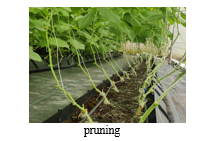
4. Monitoring and Adjusting pH
In order to uphold optimal hydroponic conditions for cultivating cucumbers, it is essential to regularly monitor the pH levels and make necessary adjustments using appropriate pH Down or pH Up solutions.
IV. COMMON PESTS IN HYDROPONIC CUCUMBER CULTIVATION
Despite providing a regulated and productive setting for growing cucumbers, hydroponic trough systems constantly face the persistent challenge of insect and pest infestations.
A. Aphids
These minuscule insects that extract sap have the ability to rapidly reproduce and inflict harm on cucumber plants. They accomplish this by ingesting sap, which leads to hindered growth and the transmission of diseases.
These insects possess the ability to diminish the vitality of plants, hinder their growth, induce metabolic disruptions, and contort the appearance of plant leaves. Moreover, aphids serve as carriers for viruses and can consequently transmit the Cucumber mosaic virus (CMV), particularly in cucumber plants.
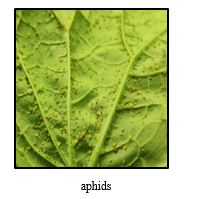
B. Spider Mites
Spider mites, which are minuscule arachnids, sustain themselves by puncturing the tender tissue of leaves or stems and consuming plant sap. Their activities can result in substantial harm to plants, encompassing discoloured and stippled leaves, growth irregularities, and in some cases, even death.
C. Whiteflies
These diminutive insects with wings derive their nourishment from the sap of plants, resulting in the withering and discoloration of foliage, as well as the transmission of viral pathogens.
D. Thrips
Small, slim arthropods that consume foliage. This results in significant harm to the vegetation, which is marked by distortion, blemishes, and shimmering areas.
- Integrated Pest Management (IPM) Strategies
a. Biological Controls
In order to establish a harmonious and balanced ecosystem within the hydroponic trough system, it is recommended to introduce indigenous natural predators including ladybugs, predatory mites, or parasitic wasps. These beneficial organisms possess the capability to prey upon common pests, subsequently controlling their population and contributing to the overall sustainability of the system. By implementing this approach, a natural and effective method of pest management can be achieved, reducing the reliance on pesticides and promoting the well-being of the hydroponic environment.
b. Neem Oil
Neem oil, an alternative that is both organic and biodegradable, effectively disrupts the feeding and reproductive patterns of pests, serving as a potent deterrent.
c. Insecticidal Soaps
Insecticidal soaps possess an effective attribute of being gentle on plants, while simultaneously showcasing lethal effects on pests. By disturbing the external protective layer of insects, such soaps induce dehydration, ultimately resulting in the complete eradication of these pests.
d. Yellow Sticky Trap
Yellow sticky traps were created to monitor insect numbers in the field by attracting and catching flies with sticky yellow glue. Regular checks of the glue reveal the number of trapped insects, and a sudden increase indicates the need for insect population control measures. While yellow sticky traps are effective for controlling white flies, thrips, winged aphids, and leaf miners in greenhouses, they are not as effective in open fields.
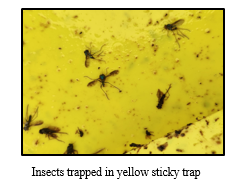
2. Preventive Measures
a. Quarantine New Plants
Prior to incorporating new plants into the hydroponic system, it is essential to subject them to a quarantine period to verify their freedom from pests. This precautionary measure acts as a safeguard against the potential introduction of any harmful organisms that could pose a threat to the existing crop.
b. Proper Ventilation
To discourage the growth of conditions that are conducive to pests, it is crucial to maintain optimal air circulation within the hydroponic environment. Additionally, sufficient ventilation plays a vital role in promoting a healthier ecosystem for plant growth.
c. Regular Monitoring
Regularly monitoring plants for indications of pests, such as deformed foliage, abnormal colouring, or the actual presence of insects or rodents, is essential. Timely identification permits prompt action to address the issue effectively.
d. Hygiene Practices
It is crucial to uphold cleanliness within the hydroponic trough system and its surrounding areas. It is essential to promptly eliminate any plant debris, as the decomposition of these materials can allure pests
3. Organic Pest Control Methods
a. Diatomaceous Earth
Derived from the fossilised remains of diatoms, can be utilised as a powdery substance to establish a protective barrier against creeping insects when applied to the cultivation medium.
b. Garlic and Pepper Sprays
Garlic and pepper extracts can be combined to create deterrent sprays, which effectively establish an unwelcoming atmosphere for pests.
V. FREQUENTLY ENCOUNTERED DISEASES IN HYDROPONIC CUCUMBER CULTIVATION
A. Powdery Mildew
Characterised by the formation of white powdery spots on the leaves, powdery mildew is a fungal disease that detrimentally affects plant health by reducing photosynthesis.
B. Downy Mildew
Displaying symptoms such as yellowing leaves accompanied by a growth resembling a downy texture on the undersides, downy mildew is another fungal disease that hinders nutrient absorption in plants.
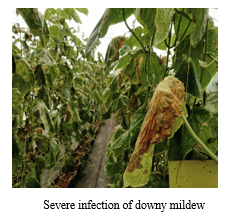
C. Pythium Root Rot
As a pathogen that spreads through water, Pythium can cause a debilitating condition known as root rot, resulting in wilting, stunted growth, and a decline in overall plant vitality.
D. Fusarium Wilt
Thriving in the soil, Fusarium is a fungal disease that clogs the plant's vascular system, ultimately leading to wilting, yellowing, and eventually, the demise of the plant.
- Disease Prevention Strategies
a. Hygiene and Sanitation
It is crucial to maintain a hygienic and sanitised hydroponic environment by consistently removing debris and ensuring that all equipment and tools are properly disinfected. This practice significantly reduces the risk of disease transmission.
b. Proper Ventilation
To prevent the development of fungal diseases, it is essential to maintain adequate air circulation within the hydroponic system. Good ventilation plays a vital role in maintaining optimal humidity levels.
c. Quarantine New Plants
Before introducing new plants into the hydroponic system, it is important to isolate them. This precautionary measure helps prevent the potential introduction of diseases from external sources.
d. Monitoring and Early Detection
Regularly monitoring plants for any signs of disease, such as unusual spots, discoloration, or wilting, is crucial. Early detection enables prompt intervention and effectively minimises the spread of diseases.
2. Disease-Resistant Cucumber Varieties
a. Opt for Resistant Varieties
When selecting cucumber cultivars for hydroponic systems, it is advisable to choose those that are renowned for their resilience against prevalent diseases. By opting for disease-resistant cultivars, growers can incorporate an additional level of safeguarding against potential infections.
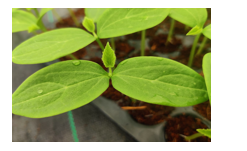
b. Genetic Resistance
An alternative approach to combat diseases in hydroponic systems is to delve into the realm of genetic engineering. By exploring the latest developments in this field, growers can discover cucumber varieties that have been meticulously bred to possess enhanced resistance to commonly occurring diseases.
3. Cultural Practices for Disease Management
a. Maintaining Optimal Water Usage
Implement effective water management strategies to avoid excessive watering and minimise the likelihood of waterborne illnesses, such as Pythium root rot.
b. Achieving Nutritional Equilibrium
Establish a well-balanced nutrient solution to enhance the overall well-being of plants and enhance their ability to withstand diseases. Inadequate nutrient levels can render plants more vulnerable to infections.
c. Regulating Temperature
Control the temperature levels within the hydroponic system, as certain diseases flourish in particular temperature ranges. Sustaining ideal conditions diminishes the probability of disease outbreaks.
4. Bio Methods & Organic Remedies
a. Beneficial Microorganisms
Incorporate advantageous microorganisms like mycorrhizae and beneficial bacteria into the hydroponic system. These microorganisms have the potential to bolster the plant's innate defence mechanisms against diseases
b. Organic Fungicides
Explore the utilisation of organic fungicides, such as neem oil or copper-based solutions, for managing fungal diseases. These environmentally-friendly alternatives have proven efficacy against specific pathogens.
Conclusion
Hydroponics is transforming the field of agriculture by addressing the challenges faced by traditional farming methods. In a world with a rapidly growing population, it is more crucial than ever to ensure efficient and sustainable food production. Hydroponics provides innovative solutions and opportunities for a greener future. One of the key components of hydroponics is the use of trough systems, which are both efficient and sustainable, making them essential in the pursuit of resilient agriculture. These systems are particularly valuable in the cultivation of cucumbers, as they provide a controlled environment and help conserve resources. By embracing hydroponic trough systems, farmers can contribute to a productive and sustainable agricultural future. To protect cucumber crops in hydroponic trough systems from insect and pest attacks, it is vital to take a proactive and multifaceted approach. This involves integrating strategies for integrated pest management, implementing preventive measures, and utilising organic control methods. By doing so, growers can ensure a robust and thriving cucumber harvest while maximizing the advantages of hydroponic cultivation and minimizing the potential risks associated with pests. In order to effectively manage diseases in hydroponic cucumber cultivation, a proactive and comprehensive approach is necessary. This includes implementing preventive measures, selecting disease-resistant cultivars, and adopting cultural practices that promote overall plant health. By maintaining high standards of hygiene, promptly identifying any signs of disease, and incorporating biological controls, hydroponic cucumber crops can thrive, resulting in a healthy and abundant harvest.
References
[1] Ellis J. “Agricultural transparency reconnecting urban centres with food production”. Dalhousie University, School of Architecture, Halifax, Nova Scotia (2012). [2] Resh and Howard. “Hydroponic Food Production”. CRC Press (2004): 157. [3] Department of Agriculture. “Hydroponics” (2014). [4] “Hydroponics Guide”. [5] Anonymous. “Hydroponics”. Department of Agriculture, Ministry of Agriculture (2013): 1- 45. [6] Davis UC. “Soilless Culture of Greenhouse Vegetables”. Vegetable Research and Information Center (2014): 1-12. [7] Kusinara Wijayabandara. “How to plan a hydroponic garden? Board of study in plant sciences”. Sciscitator 1 (2014): 1-12. [8] Amrita Sengupta and Hirak Banerjee. “Soil-less culture in modern agriculture”. World Journal of Science and Technology 2.7 (2012): 103-108. [9] Ikeda H, Koohakan P, Jaenaksorn T. Problems and counter measures in there use of the nutrient solution in soilless production. Acta Horticulturae. 2002; 578:213-219. [10] Jovicich E, Cantliffe DJ, Stoffella PJ. Spanish pepper trellis system and high plant density can increase fruit yield, fruit quality and reduce labour in a hydroponic, passive-ventilated greenhouse. Acta Horticulturae. 2003; 614:255-262. [11] Kirimura M, Inden H. Effects of set point of NH4-N concentration on pH fluctuation in ion concentra-tioncontrolled hydroponics in cucumber. Journal of Science and High Technology in Agriculture (Ja-pan). 2005;17:199-204. [12] Maboko MM, Plooy CP, Bertling I. Comparative performance of tomato cultivars cultivated in two hydroponic production systems. South African Journal of Plant and Soil. 2011; 28(2):97-102. [13] Manzocco L, Foschia M, Tomasi N, Maifreni M, Costa LD, Marino M et al. Influence of hydroponic and soil cultivation on quality and shelf life of ready-to-eat lamb’s lettuce (Valerianella locusta L. Laterr). Journal of Science Food and Agriculture. 2011; 91(8):1373-1380. [14] Mwazi FN, Amoonga S, Mubiana FS. Evaluation of the effect of salinity on spinach (Beta vulgaris var cicla) grown in hydroponic system along the coast of Namibia. Agricola, 2010, 14-17. [15] Nielsen CJ, Ferrin DM, Stanghellin ME. Efficacy of biosurfactants in the management of Phytophthora capsici on pepper in recirculating hydroponic systems. Canadian Journal of Plant Pathology. 2006; 28(3):450- 460. [16] Nisha Sharma, Somen Acharya, Kaushal Kumar, Narendra Singh, Chaurasia OP. Hydroponics as an advanced technique for vegetable production: An overview, Journal of Soil and Water Conservation. 2018; 17(4):364-371. [17] Polycarpou P, Neokleous D, Chimonidou D, Papadopoulos I. A closed system for soil less culture adapted to the Cyprus conditions. In: Hamdy A. (ed), F. El Gamal AN, Lamaddalen C. Bogliotti, and R. Guelloubi. Non-conventional water use, 2005, 237-241. [18] Resh HM. Hydroponic Food Production: a Definitive Guidebook for the Advanced Home Gardener and the Commercial Hydroponic Grower. CRC Press, Boca Raton FL, 2013. [19] Rouphael Y, Colla G. Growth, yield, fruit quality and nutrient uptake of hydroponically cultivated zucchini squash as affected by irrigation systems and growing seasons. Scientia Horticulturae. 2005; 105(2):177-195. [20] Singh S, Singh BS. Hydroponics – A technique for cultivation of vegetables and medicinal plants. In. Proceedings of 4th Global conference on – Horticulture for Food, Nutrition and Livelihood Options. Bhubaneshwar, Odisha, India, 2012, 220.
Copyright
Copyright © 2024 Muhammed Safvan. This is an open access article distributed under the Creative Commons Attribution License, which permits unrestricted use, distribution, and reproduction in any medium, provided the original work is properly cited.

Download Paper
Paper Id : IJRASET58243
Publish Date : 2024-01-31
ISSN : 2321-9653
Publisher Name : IJRASET
DOI Link : Click Here
 Submit Paper Online
Submit Paper Online

